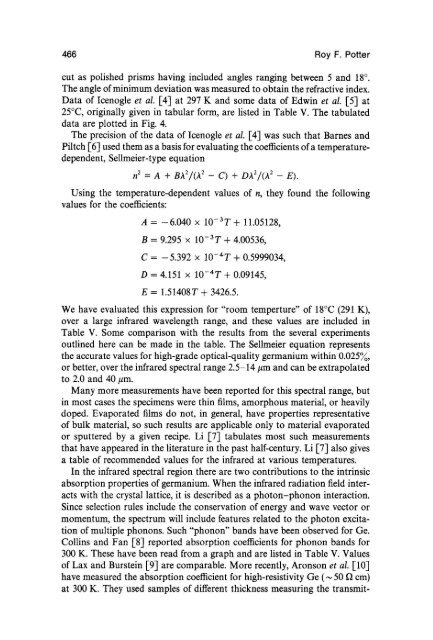Gallium Arsenide (GaAs) - Courses
Gallium Arsenide (GaAs) - Courses
Gallium Arsenide (GaAs) - Courses
You also want an ePaper? Increase the reach of your titles
YUMPU automatically turns print PDFs into web optimized ePapers that Google loves.
466 Roy F. Potter<br />
cut as polished prisms having included angles ranging between 5 and 18°.<br />
The angle of minimum deviation was measured to obtain the refractive index.<br />
Data of Icenogle et al. [4] at 297 K and some data of Edwin et al. [5] at<br />
25°C, originally given in tabular form, are listed in Table V. The tabulated<br />
data are plotted in Fig. 4.<br />
The precision of the data of Icenogle et al. [4] was such that Barnes and<br />
Piltch [6] used them as a basis for evaluating the coefficients of a temperaturedependent,<br />
Sellmeier-type equation<br />
n 2 = A + BA 2 /(J.? - C) + DA 2 /(A 2 - E).<br />
Using the temperature-dependent values of n, they found the following<br />
values for the coefficients:<br />
A = -6.040 x 1O- 3 T + 11.05128,<br />
B = 9.295 x 1O- 3 T + 4.00536,<br />
C = -5.392 x 1O- 4 T + 0.5999034,<br />
D = 4.151 x 1O- 4 T + 0.09145,<br />
E = 1.51408T + 3426.5.<br />
We have evaluated this expression for "room temperture" of 18°C (291 K),<br />
over a large infrared wavelength range, and these values are included in<br />
Table V. Some comparison with the results from the several experiments<br />
outlined here can be made in the table. The Sellmeier equation represents<br />
the accurate values for high-grade optical-quality germanium within 0.025%,<br />
or better, over the infrared spectral range 2.5-14 p.m and can be extrapolated<br />
to 2.0 and 40 p.m.<br />
Many more measurements have been reported for this spectral range, but<br />
in most cases the specimens were thin films, amorphous material, or heavily<br />
doped. Evaporated films do not, in general, have properties representative<br />
of bulk material, so such results are applicable only to material evaporated<br />
or sputtered by a given recipe. Li [7] tabulates most such measurements<br />
that have appeared in the literature in the past half-century. Li [7] also gives<br />
a table of recommended values for the infrared at various temperatures.<br />
In the infrared spectral region there are two contributions to the intrinsic<br />
absorption properties of germanium. When the infrared radiation field interacts<br />
with the crystal lattice, it is described as a photon-phonon interaction.<br />
Since selection rules include the conservation of energy and wave vector or<br />
momentum, the spectrum will include features related to the photon excitation<br />
of multiple phonons. Such "phonon" bands have been observed for Ge.<br />
Collins and Fan [8] reported absorption coefficients for phonon bands for<br />
300 K. These have been read from a graph and are listed in Table V. Values<br />
of Lax and Burstein [9] are comparable. More recently, Aronson et al. [10]<br />
have measured the absorption coefficient for high-resistivity Ge ( '" 50 n em)<br />
at 300 K. They used samples of different thickness measuring the transmit-
















